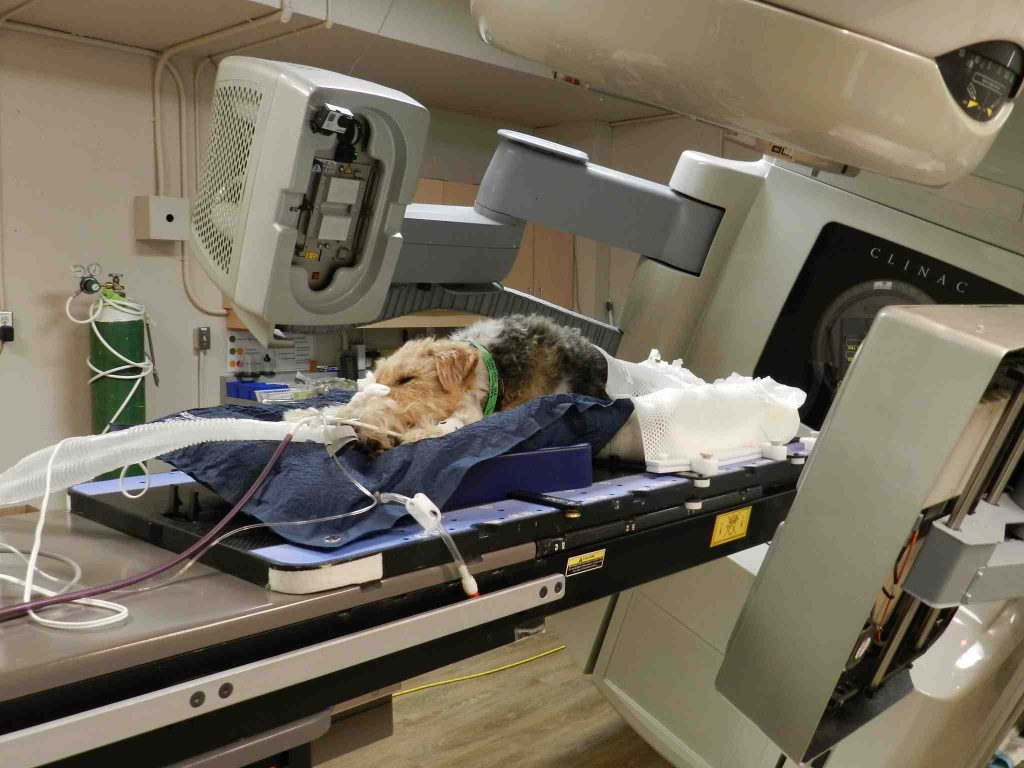
Recent advances in veterinary medicine allow vets to more accurately diagnose the type and location of tumours in our pets. And that, when combined with cutting-edge equipment, means today’s radiation therapy is more accurate and effective than ever before with fewer side effects and damage to normal cells.
In a nutshell, radiation therapy focuses beams of radiation directly on a tumour, with the goal of destroying the tumour’s ability to divide and grow. During radiation therapy both cancer cells and normal cells are affected but because radiation is targeted to a very specific area, damage to normal cells is limited.
Many different types of pet cancers can benefit from radiation therapy including tumours in the mouth and nasal cavities; some mast cell tumours, squamous cell carcinomas and soft tissue sarcomas; lymphoma; and osteosarcoma to name a few.
Radiation therapy can be used alone or in conjunction with surgery and/or chemotherapy in order to control the growth of a tumour, shrink the tumour or destroy it altogether. This form of cancer treatment is used on tumours that have not spread to other organs in the body.
If a tumour cannot be completely removed — usually because of its size and/or location — radiation therapy is often used post surgery to help destroy any remaining cancer cells or control the growth of the tumour.
In some cases radiation therapy can be used alone when surgery is not an option or it can be used in a palliative manner by shrinking the tumour, which helps to alleviate pain and improve the pet’s quality of life.
Radiation therapy is administered with the help of a very specialized piece of equipment called a Linear Accelerator. It’s critical that the pet lies perfectly still during treatments so general anesthesia is required for each treatment.
Prior to the first radiation therapy session, the pet will undergo several tests — which may include x-rays, MRIs and CAT scans — to determine the exact location of the tumour. This data is used to develop a custom radiation treatment plan for the pet and to set up the radiation therapy equipment for the pet’s initial and subsequent treatments.
The frequency and duration of radiation therapy treatments will depend on the specialized equipment used, the pet’s size, general state of health, the type and location of the tumour and whether radiation therapy is used post surgery or for palliative care.
The side effects of radiation therapy depend on the type and dose of radiation administered. Side effects occur most often during or shortly after treatment and may include:
Many pet guardians are very concerned about the risks associated with general anesthesia. Vets estimate that about one in 100,000 pets have a reaction to anesthesia. These risks can be minor such as swelling at the injection site or life-threatening such as anaphylactic shock.
Although the risks are very real for pets undergoing general anesthesia, veterinarians take great care to minimize the risk to your pet through anesthesia protocols that meet the specific needs of your pet, careful monitoring while your pet is under anesthesia and proper aftercare.
Sources:
This page has been reviewed by our Panel of Experts for accuracy. Our Panel of Experts is comprised of practitioners with varying specialties and perspectives. As such, the views expressed here may not be shared by all members of our Panel.
The content on this website is for informational purposes only and is not intended to be a substitute for professional veterinary medical advice, diagnosis or treatment.